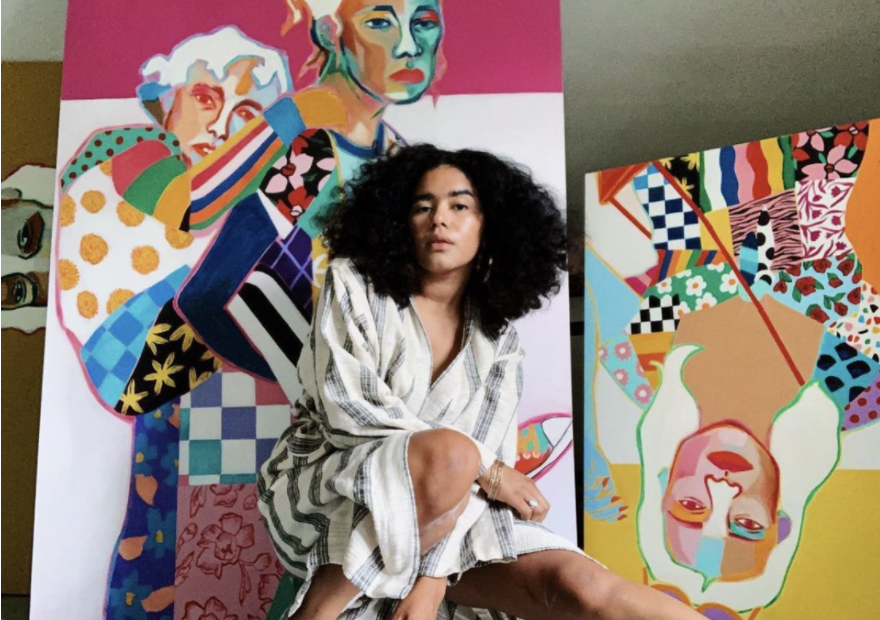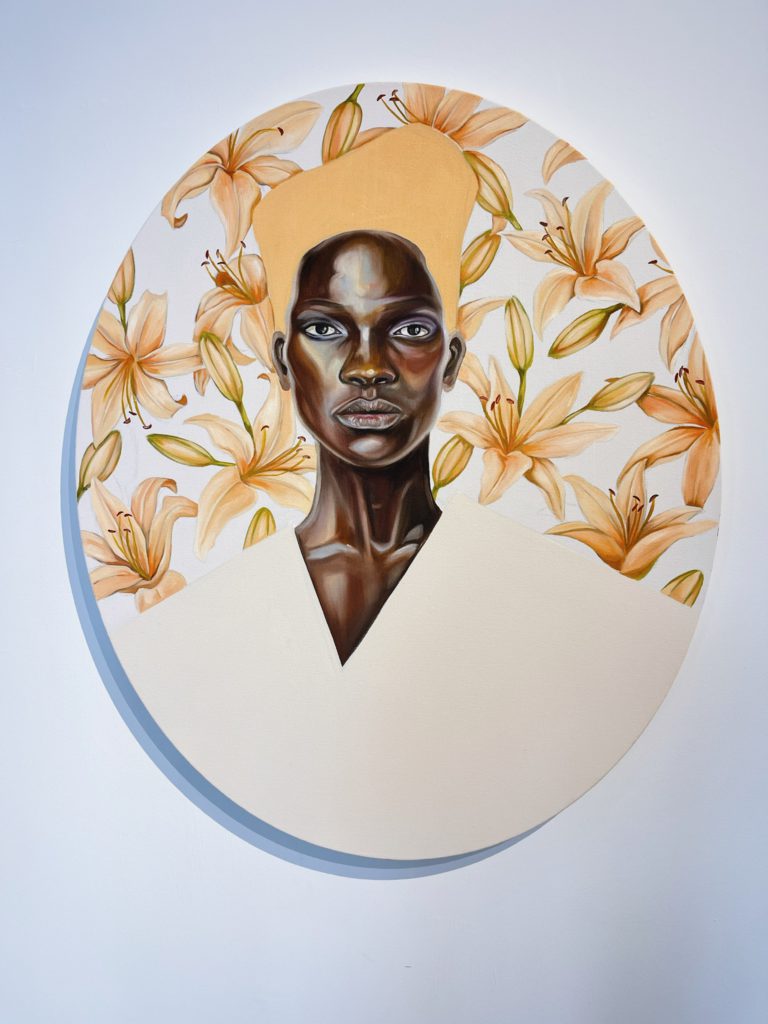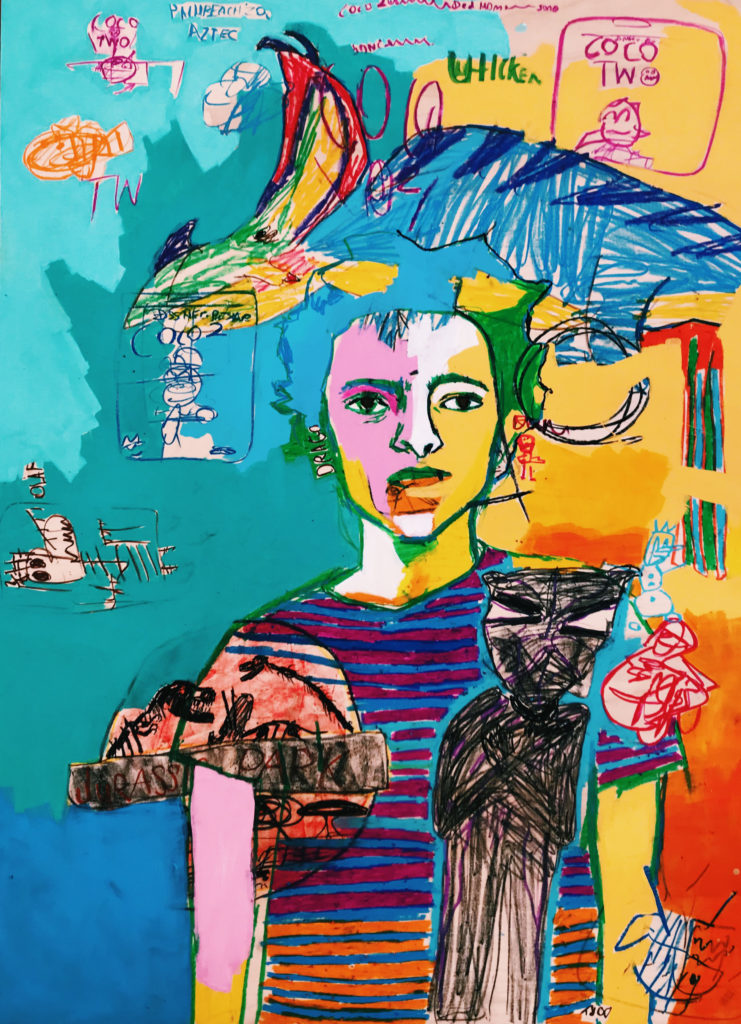This Black History Month, we’re championing the extraordinary Black entrepreneurs at the heart of our creative community: from workshops featuring Black trailblazers during Creatively Classes to content programming that spotlights intrepid Black creators, including Lauren Pearce.
When Lauren Pearce sits down to paint a portrait, she prepares her palette not only with rich skin tones but also seagreen blues, fiery reds, and canary yellows. Pearce is a visual artist based in Cleveland, Ohio, who finds inspiration from her community when creating the powerful, mixed-media masterpieces she’s become known for. Focusing on the human form, her work explores themes of motherhood, trauma, race, identity, and self-acceptance. Pearce has exhibited her work in both solo and group shows in New York, London, Miami, Cleveland, and Los Angeles.
As a black, biracial woman, Pearce’s craving to express her identity quickly turned into an artistic career. Utilizing an array of materials, Pearce taps into her imagination to bring forth the colorful language of identity, race, and womanhood that shape her experience of the world. Although her output ranges from self portraits and blind contour line drawings to ceramic masks and large-scale murals, one element is consistent across her body of work: color. Pearce’s “Geo” series features geometric portraits in an aesthetic reminiscent of Cubism, whereas “Life in Color” makes use of bold, bright hues in patchwork patterns with a Fauvist flair. Make no mistake, Pearce is also a virtuosic realist whose incredible talent for depicting every nuance of a person’s face grants her a certain freedom: it’s the masters of realism who can turn most easily to abstraction, creating an expanded vocabulary with which to portray their subjects.
You can check out more of their work here.

What is the first creative project you remember?
The creative project that stands out the most is from the time I spent in France. I was a junior heading into my senior year of high school and I went on a three-week summer program with my art teachers. During this time, we got to see where Cezanne painted. We each had our own studios to work and create everyday. I remember one piece in particular that I created, it was a dress. It was my first time sewing and I so desperately wanted to create something that came from these beautiful textiles that I saw on one of our trips while we were there. There was something so whimsical about it that I wanted to translate into a garment.
Describe your aesthetic in three words.
My aesthetic in art would have to be along the lines of peace and joy. I think when I really meditate on what I want to convey through my work I want the viewer to feel a sense of ease and curiosity, asking “who are these people?” Many of my works give off a sense of knowing. It’s as though the individuals I am painting really see the person you are.

What was the most fulfilling collaboration you’ve worked on?
Hands down, my collaboration with both of my children. The series “Us” was about our journey with autism as a family. My son, Keegan, who is autistic, would spend hours upon hours drawing and creating at our dining room table. For many years, this was his form of communication. It was important to me as his mother to give him the space to share a part of his story. Not just for Keegan but also for Dylan, being the older sibling of an autistic individual. I truly believe that this gift I have has helped me in understanding my son better. It has been a bridge of communication when words could not be. We got to share parts of ourselves as a family through art; that was the show that meant the most to me.

What’s one creative project that taught you something fundamental about yourself?
I just recently had an opening in my hometown of West Palm Beach, Florida. It was in the process of creating this work that I truly embraced all parts of myself. It was in this show that I felt the most grounded in who I am, the most secure in what I have to offer, and the most alive. This show sparked something very real and true in myself. I learned that I am enough, that I am capable, and how to rely on the people around me. I often struggle with asking for help but this show forced me to have to ask. There was this sense of peace, even in the setbacks. It’s as though this work was guiding me to a more secure and peaceful place. There was a lot of surrendering that had to happen during this experience.
Do you think creativity is something you’re born with, or something you’re taught?
I feel like this is the question, the one that so many people are torn between. Honestly, I think creativity is something that can be taught. However, being a true artist and a creative person are very different. I think there are people that are born with true, raw, undeniable talent. There are also people who have been taught to break down the barriers and who have been shown the way to creativity. I think there are artists who are just born with that fire, that capability to stir your emotions and make you feel completely connected to what they are manifesting and creating.

What’s the last dream you had?
I honestly can’t even remember the last dream I had. The last thought I had about something that I wish would happen was to have a solo show in Paris.
One hundred years from now, what do you hope people write about your work?
I hope they write about it being honest. I want my work to always be true to myself and to the people around me. I hope that people many, many years from now will still find peace in my subjects’ gaze and feel a kinship with them. I want them to look at my work and know that things are possible.

What advice would you give fellow Black creatives/entrepreneurs just getting started?
Trust yourself, but also build meaningful relationships with other Black artists—it’s not a competition. Find like-minded artists that will support you genuinely. We need each other. Don’t be afraid to ask questions, don’t be afraid to ask for advice. But also be honest with yourself and your work. We don’t have to create one thing. Know and believe that your individual story carries more weight than any other generalized, stereotypical narrative.
Follow @laurenpearce on Creatively
Creatively is more than a platform—we’re a creative collective.
Questions or feedback? Email us at feedback@creatively.life

